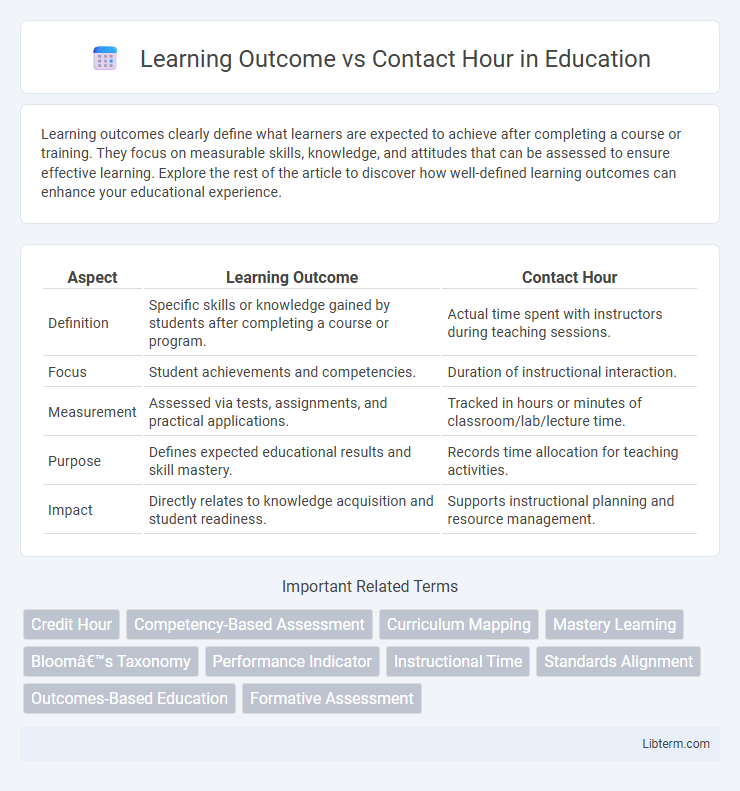Learning outcomes clearly define what learners are expected to achieve after completing a course or training. They focus on measurable skills, knowledge, and attitudes that can be assessed to ensure effective learning. Explore the rest of the article to discover how well-defined learning outcomes can enhance your educational experience.
Table of Comparison
| Aspect | Learning Outcome | Contact Hour |
|---|---|---|
| Definition | Specific skills or knowledge gained by students after completing a course or program. | Actual time spent with instructors during teaching sessions. |
| Focus | Student achievements and competencies. | Duration of instructional interaction. |
| Measurement | Assessed via tests, assignments, and practical applications. | Tracked in hours or minutes of classroom/lab/lecture time. |
| Purpose | Defines expected educational results and skill mastery. | Records time allocation for teaching activities. |
| Impact | Directly relates to knowledge acquisition and student readiness. | Supports instructional planning and resource management. |
Defining Learning Outcomes in Education
Defining learning outcomes in education establishes specific, measurable knowledge and skills students are expected to achieve after instruction, aligning curriculum design with assessment criteria. Contact hours refer to the actual time students spend under direct supervision or instruction, yet they do not inherently guarantee mastery of learning outcomes without effective pedagogical strategies. Clear learning outcomes provide educators with a framework to optimize contact hours by targeting essential competencies and fostering meaningful student engagement.
Understanding the Concept of Contact Hours
Contact hours refer to the scheduled time students spend directly interacting with instructors through lectures, tutorials, or practical sessions, crucial for delivering course content effectively. Understanding contact hours helps educators design curricula that align with learning outcomes by ensuring sufficient time is allocated for achieving specific competencies. Precise measurement of contact hours supports accreditation standards and enhances student engagement by balancing instructional time with independent study requirements.
Key Differences Between Learning Outcomes and Contact Hours
Learning outcomes define the specific skills, knowledge, or competencies students are expected to achieve by the end of a course, while contact hours refer to the actual time spent in direct instructional activities such as lectures or labs. Learning outcomes emphasize measurable educational goals and assessment criteria, whereas contact hours measure the quantity of instructional time without specifying achievement levels. Understanding this distinction helps educators design curricula that balance time allocation with targeted pedagogical objectives.
Measuring Educational Success: Outcome-Based vs Time-Based Approaches
Measuring educational success involves comparing outcome-based and time-based approaches, where learning outcomes emphasize mastery of specific skills and knowledge regardless of time spent, while contact hours focus on the duration of instruction without guaranteeing competency. Outcome-based assessment provides a more accurate representation of student achievement by evaluating demonstrated performance against predefined criteria, enhancing curriculum relevance and learner accountability. In contrast, relying solely on contact hours may overlook individual learning differences and fail to ensure effective knowledge acquisition.
The Shift from Contact Hours to Competency-Based Learning
The shift from contact hours to competency-based learning emphasizes mastery of skills over time spent in class, prioritizing measurable learning outcomes rather than seat time. This approach aligns educational goals with student abilities, fostering personalized pacing and deeper understanding of subject matter. Competency-based learning frameworks improve accountability by clearly defining proficiency levels and enabling flexible learning pathways.
Benefits of Focusing on Learning Outcomes
Focusing on learning outcomes rather than contact hours enhances educational effectiveness by clearly defining the skills and knowledge students must acquire, promoting targeted curriculum design and assessment. This approach facilitates personalized learning experiences and accountability, ensuring students achieve measurable competencies essential for academic and professional success. By prioritizing outcomes, institutions improve quality assurance and align teaching strategies with industry or academic standards, maximizing the value of instructional time.
Limitations of the Contact Hour Model
The Contact Hour model primarily measures time spent in instructional settings but fails to account for actual student learning or mastery of competencies. This approach overlooks variations in individual learning pace, engagement, and the effectiveness of different teaching methods, limiting its accuracy as a sole indicator of educational achievement. Consequently, reliance on contact hours can misrepresent learning outcomes and hinder the development of competency-based education frameworks.
Impact on Curriculum Design and Student Assessment
Learning outcomes define the specific skills and knowledge students are expected to achieve, guiding curriculum design to ensure alignment with educational goals. Contact hours represent the time allocated for instruction, influencing the depth and pacing of content delivery. Balancing learning outcomes with contact hours enhances student assessment by providing clear benchmarks for evaluating competency within the allotted instructional timeframe.
Accreditation Standards: Learning Outcomes vs Contact Hour Requirements
Accreditation standards emphasize the alignment of learning outcomes with contact hour requirements to ensure educational quality and accountability. Learning outcomes define specific skills and knowledge students must acquire, while contact hours quantify instructional time necessary to achieve these outcomes. Institutions must demonstrate that contact hours are sufficient and effectively structured to meet or exceed the prescribed learning outcomes, aligning with accrediting bodies' criteria for program evaluation and certification.
Future Trends in Educational Measurement and Evaluation
Future trends in educational measurement and evaluation emphasize aligning learning outcomes more precisely with contact hours to optimize instructional effectiveness and student achievement. Advances in adaptive learning technologies enable real-time assessment adjustments, ensuring contact hours are directly linked to measurable competency gains. Data analytics and AI-driven evaluation tools are increasingly used to predict and enhance learning outcomes, transforming traditional contact hour metrics into dynamic, outcome-focused educational frameworks.
Learning Outcome Infographic

 libterm.com
libterm.com